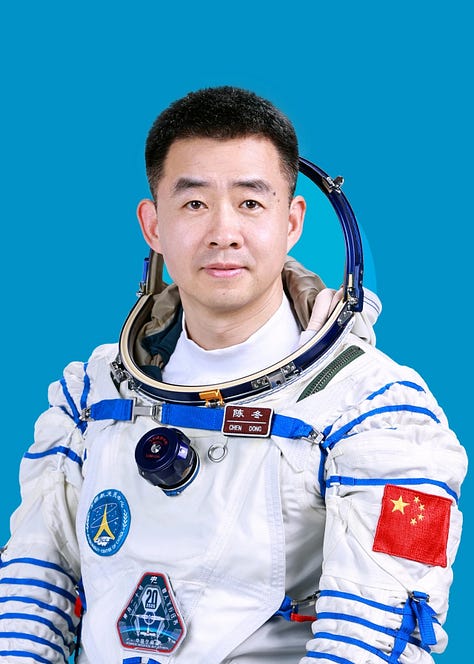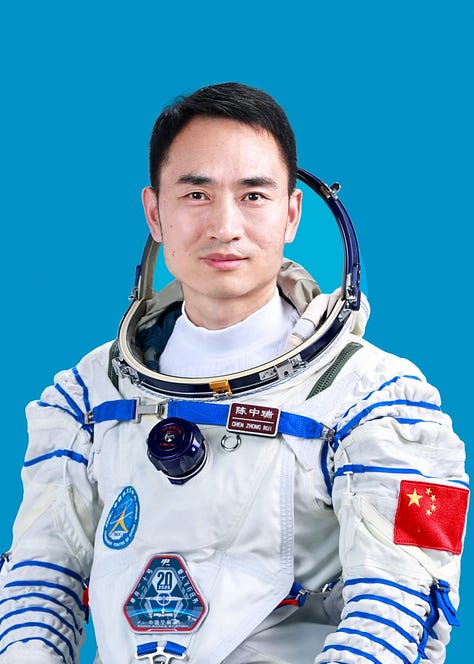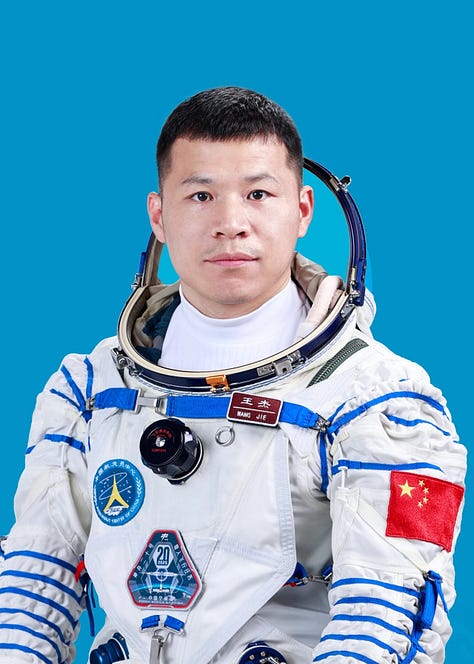Shenzhou-20 Taikonauts Return Aboard Shenzhou-21 Spacecraft Following Debris Concerns
Chen Dong, Chen Zhongrui, and Wang Jie are back on Earth after 204 days in space.

Over the course of around six hours, the Shenzhou-21 spacecraft undocked from the Tianhe module’s forward-facing port at the Tiangong Space Station at 11:14 am China Standard Time (03:14 am Universal Coordinated Time), to move to a safe distance for return, first jettisoning the orbital module. After that, the service module performed the deorbit burn for itself and the reentry capsule with the crew inside, separating afterward for reentry.
On November 14th at 16:41 pm China Standard Time (08:41 am Universal Coordinated Time), the Shenzhou-21 spacecraft carrying Shenzhou-20’s Commander Chen Dong (陈冬), Operator Chen Zhongrui (陈中瑞), and Science Operator Wang Jie (王杰) softly touched down after descending under a parachute.
Minutes after touchdown, recovery teams approached the reentry capsule and extracted the crew one by one, as well as experiments brought back with them. With their extraction, Chen Dong has spent a national record-leading 418 days in space across three missions, while Wang Jie and Chen Dong have accumulated 204 days in space for their first missions. The three taikonauts briefly spoke to the media after landing:
Chen Dong: “Taking the Shenzhou-21 spaceship has reassured our steps to discover the universe; space exploration will never stop and is full of challenges and uncertainties, but that’s exactly why we’re taking this road. I believe this mission is a great test for all of us, and we are very proud to have finished our mission completely and successfully. In the past few days, we have received a lot of attention and care from the country and the people. We deeply feel that the manned spaceflight mission has always put the priority on people’s lives, to taikonaut safety. I want to thank our country and all of the professionals who have contributed to our safe return. We’re back and we’re proud of our country.”
Chen Zhongrui: “On April 24th, we set off to space, and we carried out a mission of around half a year. We’ve been working closely with my colleagues, and we have fulfilled all of our missions and the tasks handed to us by the party and the people. We are very proud and very happy; we want to thank all of the space professionals for their efforts and our country, to fulfill the dream of prosperity.”
Wang Jie: “Well, after half a year and finally safely return home and feel gravity again feels great. So the space trip is not only a chance to fulfill my dreams, but also a trip full of challenges and difficulties, and I’ve also grown and learned a lot. I’d like to thank all of the people who have supported me and care about me. I believe that the success of the mission would not be possible without the efforts of all the space professionals of China, and it represents that China is now making huge progress in space and especially in manned space missions. In the future, I will remain firmly part of this effort and will contribute what I can.”

Now out of the spacecraft, the three taikonauts will undergo medical checks before flying to Beijing (北京) for comprehensive post-mission checks and adjustment back to life on Earth.
Returning to Earth alongside Shenzhou-20’s taikonauts were the first rodent residents, with two male and two female mice, of the space station, sent up with Shenzhou-21’s crew. They are part of a short-duration experiment to study their behaviours in microgravity as well as to examine the changes to their organic tissues and mammalian organs.
During their 204-day mission on board Tiangong, the Shenzhou-20 trio performed four spacewalks, the first in May, followed by June, August, and September, and tested out a companion AI system. For the handover period with the Shenzhou-21 crew, it started with a barbecue feast before the transfer of management and custodianship of the station. After their return was delayed, both crews jointly conducted experiments installed in the station and performed maintenance tasks.
Switching to Shenzhou-21
The return of the Shenzhou-20 crew onboard the Shenzhou-21 spacecraft was made out of an abundance of caution for both missions’ crews. About ten days ago, the Shenzhou-20 spacecraft was hit by a piece of space debris, with the China Manned Space Agency deciding, according to the following, via Xinhua:
“Following a comprehensive assessment, the Shenzhou-20 manned spacecraft’s return capsule window glass has developed a fine crack. The most probable cause is an external impact from space debris. This condition does not meet the clearance criteria for a safe manned return. The spacecraft will remain in orbit to conduct relevant experiments.”
If there are any problems with this translation please reach out and correct me.
Windows on the Shenzhou spacecraft, of which there are two, consist of four layers of glass with only the outer layer being resistant to the heat of reentry. Therefore, if the outer layer were to fail, the other three may too afterwards. That does not mean Shenzhou-20 could not be used as an emergency return option should something happen to Tiangong, as all three astronauts wear pressurized suits during return to Earth. A depressurization of the spacecraft would ruin most experiments onboard, greatly affecting the scientific value of the space station for a short time, but the crew would be safe.
As for the Shenzhou-21 crew, Zhang Lu (张陆), Wu Fei (武飞), and Zhang Hongzhang (张洪章), who are still onboard Tiangong, they will be receiving the Shenzhou-22 spacecraft that is currently undergoing launch preparations. It will be launched at a later date uncrewed, with the Shenzhou-22 crew assigned to and becoming that of the Shenzhou-23 mission. This may have minimal effects on a planned yearlong stay and Pakistan’s visit to the station in 2026.
Since the debris strike, the Shenzhou-20 and Shenzhou-21 crew spent thirteen days together onboard the space station. Remaining on the station together allowed for a proper investigation into what happened to the Shenzhou-20 spacecraft. It also allowed for a convenient test of Tiangong’s life support systems to provide a habitable atmosphere for six people, to assess how much additional capacity is needed in the system when new modules are launched to best utilize larger crews launched via the in-development Mengzhou spacecraft. Depending on how many consumables the two crews used, the Tianzhou-10 resupply mission can be sent up earlier than previously planned in 2026.
Rewatch the return
Livestream replays via CCTV Video News Agency and CGTN.
Meet the Shenzhou-20 crew



Chen Dong (陈冬)
For his third spaceflight, having flown for the Shenzhou-11 and Shenzhou-14 missions, Chen Dong of Luoyang (洛阳市), Henan (河南) province, born December 1978, is the Commander for the Shenzhou-20 mission. Chen was selected as a taikonaut in 2010 as part of the second batch.
Prior to his space career, Chen enlisted in the People’s Liberation Army Air Force in 1997 and joined the Communist Party of China in 1999. Following the Shenzhou-11 mission, he was awarded the Spaceflight Merit Medal (Third Class) along with the honorary title of hero taikonaut in 2016.
Chen Zhongrui (陈中瑞)
For his first spaceflight, Chen Zhongrui of Puyang (濮阳市), Henan (河南) province, born October 1984, is the Operator for the Shenzhou-20 mission. Chen was selected as a taikonaut in 2020 as part of the third batch.
Prior to his space career, Chen enlisted in the People’s Liberation Army Air Force in 2003 and joined the Communist Party of China in 2005.
Wang Jie (王杰)
For his first spaceflight, Wang Jie of Bayannur (巴彦淖尔市 / ᠪᠠᠶᠠᠨᠨᠠᠭᠤᠷ ᠬᠣᠲᠠ), in the Inner Mongolia Autonomous Region (内蒙古自治区 / ᠥᠪᠥᠷ ᠮᠣᠩᠭᠣᠯ ᠤᠨ ᠤᠨᠥᠪᠡᠷᠲᠡᠭᠨ ᠵᠠᠰᠠᠬᠤ ᠣᠷᠣᠨ), born September 1989, is the Science Operator for the Shenzhou-20 mission. Wang was selected as a taikonaut in 2020 as part of the third batch.
Prior to his space career, Wang was an engineer from the China Aerospace Science and Technology Corporation and joined the Communist Party of China in 2009.


